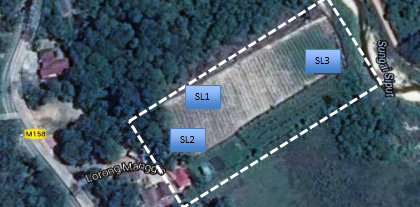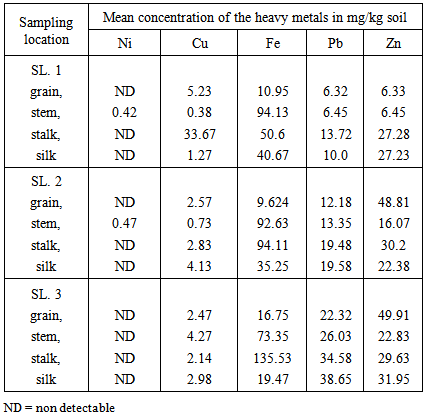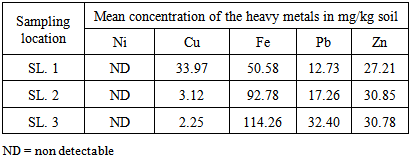-
Paper Information
- Next Paper
- Previous Paper
- Paper Submission
-
Journal Information
- About This Journal
- Editorial Board
- Current Issue
- Archive
- Author Guidelines
- Contact Us
American Journal of Environmental Engineering
p-ISSN: 2166-4633 e-ISSN: 2166-465X
2015; 5(3A): 8-12
doi:10.5923/c.ajee.201501.02
Theavy Metal Concentration (Pb, Cu, Fe, Zn, Ni) in Plant Parts of Zea Mays L. Cultivated in Agricultural Area Near Alor Gajah, Melaka, Malaysia
Khairul Nadiah Ibrahim1, Zaida Rahayu Yet2, Amelia Md. Som1, Nadia Razali1, Nurul Ain Mohamed Rahaizah1, Elmy Nahida Othman1, Nor Aini Burok3, Yushazaziah Mohd. Yunos2, Rapidah Othman4, Tengku Fazli Tengku Yahya1
1Section of Environmental Engineering Technology, Malaysian Institute of Chemical & Bioengineering Technology, Universiti Kuala Lumpur
2Section of Technical Foundation, Malaysian Institute of Chemical & Bioengineering Technology, Universiti Kuala Lumpur
3Section of Chemical Engineering Technology, Malaysian Institute of Chemical & Bioengineering Technology, Universiti Kuala Lumpur
4International College of Engineering, Malaysian Institute of Chemical & Bioengineering Technology, Universiti Kuala Lumpur
Correspondence to: Khairul Nadiah Ibrahim, Section of Environmental Engineering Technology, Malaysian Institute of Chemical & Bioengineering Technology, Universiti Kuala Lumpur.
| Email: |  |
Copyright © 2015 Scientific & Academic Publishing. All Rights Reserved.
Increasing demand for better quality and quantity of plant-based food indirectly has increased the usage of hazardous chemicals within the agricultural activity in a directly proportionate manner. If sustainable agriculture was not practiced, these hazardous substances will eventually released to the environment throughout the plant’s life cycle phases. The work reported here investigated the heavy metal concentration in maize plant cultivated in agricultural sites near Alor Gajah, situated in the state of Melaka. Extraction of the heavy metals (Pb, Cu, Fe, Zn, Ni) in maize plant parts (edible grain, stalk, stem, and silk) were carried out using dry ashing-aqua regia method. The bioavailable heavy metals in the maize plant soils were extracted using aqua regia with HCL:HNO3 (3:1 v/v). Elemental analyses were performed using atomic absorption spectrometry (AAS). The results showed that among the metals studied, the accumulation levels of Pb and Fe in maize plants were above the maximum levels as stipulated by the Malaysian Food Act (1983) and Food Regulations (1985). Pb was the highest (13.72 mg/kg-38.65 mg/kg) in stalk and silk parts and Fe was found to be the highest (40.67 mg/kg-135.53 mg/kg) in the stalk and stem parts. Despite exposure to road, rubber plantation and river none of the heavy metals studied in the soils were above the tolerable maximum limits for potentially toxic elements (PTE) by Zarcinas et. al, 2004. The heavy metal bioaccumulation in soils from all sites studied negatively affected (p<0.05) the maize plants suggesting sensitivity to the toxicants in the plant.
Keywords: Maize plants, Soils, Heavy metal accumulation, Contamination
Cite this paper: Khairul Nadiah Ibrahim, Zaida Rahayu Yet, Amelia Md. Som, Nadia Razali, Nurul Ain Mohamed Rahaizah, Elmy Nahida Othman, Nor Aini Burok, Yushazaziah Mohd. Yunos, Rapidah Othman, Tengku Fazli Tengku Yahya, Theavy Metal Concentration (Pb, Cu, Fe, Zn, Ni) in Plant Parts of Zea Mays L. Cultivated in Agricultural Area Near Alor Gajah, Melaka, Malaysia, American Journal of Environmental Engineering, Vol. 5 No. 3A, 2015, pp. 8-12. doi: 10.5923/c.ajee.201501.02.
Article Outline
1. Introduction
- Pollution by heavy metals in natural environmental is one of the environmental issues that have become a global problem. With the industrial development, the production and emission of heavy metals have increased. The nature of heavy metals to bioaccumulate cause toxicity in biological systems such as humans, animals, microorganisms and plants. Accumulation of heavy metals can reduce soil quality, reduce crop yield and the quality of agricultural products, and thus give negative impacts to the health of human, animals, and the ecosystem (Nagajyoti et al., 2010). Some metals for example manganese, copper, zinc and nickel are important and beneficial to plants, and animals, but high concentrations all these metals have strong toxic effects and pose an environmental threat (Nodelkoska, 2000). Wang and Chen (2000) reported that heavy metals are of considerable environmental concern due to their toxicity, wide sources, nonbiodegradable properties, and accumulative behaviors. According to Demirark et al. (2006) the increasing levels of heavy metals contamination that polluted the environment might be resulted from anthropogenic activities such as industrial processes, agricultural and aquaculture activities, domestic wastes, and emission from vehicles. Maize is known as one of the main food sources for human being since ancient times. It is a domesticated plant and has many beneficial uses for human and animal. Prasanna et. al (2001) reported that maize has been one of the most intensively cultivated cereals worldwide, and it is known to be the main energy source in human food, mainly in developing countries. In addition, maize can also be used in animal feed as a feedstock source in agricultural complexes (Jompuk et, al. 2011). The maize plantation studied in this research is located in Kampung Lanjut Manis, Alor Gajah, Melaka and also actually one of the biggest maize suppliers in Melaka. The maize from the plantation is mostly sold to local vendors around Melaka areas. The sampling location is located about 3 km away from the main road and also surrounded by other farms cultivating cucumber, chilies, okra and lady’s finger. It is also in close proximity to a river and rubber plantation. Being almost 40km away from the main city of Melaka and 20mins away from the nearest towns, the agricultural practices of the farmers have never been monitored. It was concluded in a study that determining heavy metals in plants is very important since human consume plants contained toxic chemicals (Krishnamurty et al., 1979). Among many other studies conducted in agricultural areas, a research on guava plant parts and soil in Perak, Malaysia, by Khairiah et. al, 2009, indicated that there are significantly high content of heavy metals in guava plants. Therefore the results of this study will provide basic information on the level of metal contents of the maize cultivated and subsequently, for the improvement of soil environment management and heavy metal pollution prevention and control in Melaka.
2. Materials and Methods
2.1. Sampling Points
- A total of three maize samples from three different location were collected for sampling activities. The first sampling location was located near to the rubber plantation (2°24'07.7"N 102°09'56.7"E), the second location (2°24'08.3"N 102°09'57.6"E) was estimated about 100 meter away near to the trunk road leading to the farm and the last location was near to a river known as Sungai Siput (2°24'09.0"N 102°09'57.9"E). The locations of sampling areas were shown in Fig. 1 and by visual observation, there was no appreciable anthropogenic interference from industrial or domestic sources at sampling location 1 and 2. However, at sampling location 3 the proximity of a river may cause some interferences.Soil samples were taken from 0-30cm depths with a plastic spade in March 2014. The weather during sampling was dry and hot with occasional drizzle of rain. The soils were immediately sealed after sampling in labeled polyethylene bags and kept in an icebox at 4°C to minimize bacterial activities and transported to the laboratory for analysis. Plants sampled were among the mature ones and exposed to full sunlight (Jones, 2001). The plants collected were transported in cloth bags separately for each part in order to maintain the integrity of the collected sample. The selected maize were plucked by bare hands to ensure that the sample is not contaminated by other materials.
 | Figure 1. Locations of the study area and the sampling stations |
2.2. Sample Preparation and Analysis
- The freshly harvested plants were brought to the laboratory and washed under running water to remove the soil, followed by three washing with distilled water. Then the plants were separated into grain, stem, stalk and silk, cut into small pieces, dried in the oven at 70oC to a constant weight and then ground into a powder with mortar and pestle (Maimon et. al, 2012). The soil samples were dried in the oven at 70°C for 24 hours and ground to pass through a 2-mm stainless steel sieve (EPA 3050b). For every sample the pH, organic matter, grain size and electroconductivity contents were determined. The results are presented in Table 1.For total digestion of plant samples, dry ashing-aqua regia method was used. 1g of dried plant samples (grain, stem, stalk and silk) were weighed and placed in silica crucible in a muffle furnace for 4hours at 500°C until white ash appeared. Sample is removed and cooled in the dessicators. Moisten sample with 1ml of concentrated nitric acid (HNO3) and evaporated to dryness at 150°C by using hot plate. Evaporated sample was placed in the heated furnace at 400°C for 15 minutes. After that, the digested sample was solubilized with 5 mL of aqua regia. For soil digestion, 0.5 g sample were weighed in 100 mL beaker, then 20 ml of aqua regia solution (3:1, v/v, HCl to HNO3) (USEPA 3051) was added into beaker and digested for 4 hours at 85°C by using hot plate. Both of the digestion method required the beaker used to be covered with watch glasses to prevent evaporation of the sample (Chen & Ma, 1998). The samples of soil and plants were then filtered by using Whatman no.1 filter paper and made up to 50 mL with distilled water for further analysis. A blank was prepared with an equal amount of acids. All reagents were of analytical grade and contained very low concentrations of trace metals. Normal precautions for trace metals analysis were observed throughout.Sample solutions and reagent blanks were analyzed for Fe, Zn, Pb, Cu, and Ni by using atomic absorption spectrophotometry (AAS) (Perkin Elmer Model 3300) at a laboratory in University of Kuala Lumpur, Malaysian Institute of Chemical and Bioengineering Technology. To determine heavy metal concentrations, the atomic absorption spectrophotometry used was with the following wavelengths (nm) Fe 248.33, Zn 213.86, Pb 283.31, Cu 324.75 and Ni 232.00. All analyses were replicated three times. Significant differences between concentrations of heavy metals, following different sampling stations were analyzed by ANOVA (SAS Institute, 1982). Statistical significance was defined as p < 0.05. Other parameters studied were soil pH (BS 1377-3:1990), percentage organic carbon (ASTMD 2974), grain size of <0.63 μm (ASTMD 2974) and soil electroconductivity (BS 1377-3:1990).
3. Results and Discussions
3.1. Heavy Metals in Maize
- Shrivastav (2001) reported that heavy metals occur in the atmosphere in particulate form and the first stage of atmospheric heavy metals was constituted by the transfer of airborne particles to land or water surfaces by dry, wet and occult deposition. The results showed that Fe was detected in the highest concentration in the stem for all three sampling locations (SL), except at SL. 1, where Fe was highest in the stalk. The analysis also showed that Cu was highest in the stalk but Zn was found to have the highest concentration in the grain for both SL. 2 and 3 except at SL. 1, with its stalk and silk contained almost similar heavy metal value indicating the highest concentration. The concentration of Pb in the whole maize was quite high at all SL particularly for station 3, where a higher level was found in the silk and stalk (Table 1).
|
3.2. Heavy Metal Concentration in Soil
- Adeleken and Abegunde (2011) reviewed that heavy metals naturally occur in all ecosystems, however, anthropogenic activities can result in higher concentrations of metal productions hence contribute to the pollution. The metal content data determined by means of the aqua regia digestion procedure are shown in Table 2. In order to evaluate the effects of the agricultural activities on the heavy metal content of these soils, only the elements related to mobile sources (Cu, Pb and Zn) were considered, because Fe are closely related to the soil type.
|
|
4. Conclusions
- Heavy metal contaminants were found to have constituted a major factor of environmental pollution risk in maize cultivated in Kg Lanjut Manis. The heavy metal concentration namely copper (Cu), iron (Fe), zinc (Zn), lead (Pb), and nickel (Ni) in plants and soil of maize were analyzed using AAS Perkin Elmer Analyst 200. Accumulation and distribution of metals in plant varied depending on the types and parts of plant, metals and the soil types studied. From the study, it is indicated that Fe has the highest overall concentration followed by zinc (Zn), lead (Pb), copper (Cu) and nickel (Ni). The sequence of metal accumulation in decreasing order was: Fe > Zn > Pb > Cu > Ni with soil, stalk and stem of plant showing a higher tendency of metal accumulation as compared to the maize silk and grain. Most of the soil samples showed insignificant concentration of nickel except for plant part, which is the stem. Uptake of metals by plants depended on the availability of the metals in the soil, which expected to be affected mostly by soil pH, grain size and organic matter. The pH of the maize soils from all the sampling points ranged from 4.77 to 4.93, which give rise to metal solubility down the soil profiles. The degradation and depletion of the soil environment are a consequence of human activities such as the deposition and discharge agricultural residues on lands and water bodies including increase in the use of fertilizers and pesticides used within the study site. The most potentially toxic elements accumulated in the soil and part of plant beyond the tolerable safe limits of Malaysian Food Act (1983) and its regulation (1985) and Food and Agriculture Organization / World health Organization (FAO/WHO) (1984) were Pb and Fe both from the maize grain, irrespective of the sites from which the samples were taken. While the other plant parts; stem, stalk and silk were also found to contain these metals indicating an unsafe use for animal feedstock. The selected heavy metal concentration of soil however does not exceeded and below the Dutch targeted value.
ACKNOWLEDGEMENTS
- We would like to acknowledge Malaysian Institute of Chemical and Bioengineering Technology, University of Kuala Lumpur for financial support and also the laboratory assistants for sampling and analysing the soil samples.
 Abstract
Abstract Reference
Reference Full-Text PDF
Full-Text PDF Full-text HTML
Full-text HTML

